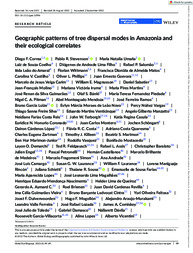Geographic patterns of tree dispersal modes in Amazonia and their ecological correlates.
Geographic patterns of tree dispersal modes in Amazonia and their ecological correlates.
Autoria: CASTILHO, C. V. de; MEDEIROS, M. B. de; SIMON, M. F.; FERREIRA, J. N.; GUEDES, M. C.; RUSCHEL, A. R.
Resumo: Aim: To investigate the geographic patterns and ecological correlates in the geographic distribution of the most common tree dispersal modes in Amazonia (endozoochory, synzoochory, anemochory and hydrochory). We examined if the proportional abundance of these dispersal modes could be explained by the availability of dispersal agents (disperser-availability hypothesis) and/or the availability of resources for constructing zoochorous fruits (resource-availability hypothesis). Time period: Tree-inventory plots established between 1934 and 2019. Major taxa studied: Trees with a diameter at breast height (DBH) ≥ 9.55 cm. Location: Amazonia, here defined as the lowland rain forests of the Amazon River basin and the Guiana Shield. Methods: We assigned dispersal modes to a total of 5433 species and morphospecies within 1877 tree-inventory plots across terra-firme, seasonally flooded, and permanently flooded forests. We investigated geographic patterns in the proportional abundance of dispersal modes. We performed an abundance-weighted mean pairwise distance (MPD) test and fit generalized linear models (GLMs) to explain the geographic distribution of dispersal modes. Results: Anemochory was significantly, positively associated with mean annual wind speed, and hydrochory was significantly higher in flooded forests. Dispersal modes did not consistently show significant associations with the availability of resources for constructing zoochorous fruits. A lower dissimilarity in dispersal modes, resulting from a higher dominance of endozoochory, occurred in terra-firme forests (excluding podzols) compared to flooded forests. Main conclusions: The disperser-availability hypothesis was well supported for abiotic dispersal modes (anemochory and hydrochory). The availability of resources for constructing zoochorous fruits seems an unlikely explanation for the distribution of dispersal modes in Amazonia. The association between frugivores and the proportional abundance of zoochory requires further research, as tree recruitment not only depends on dispersal vectors but also on conditions that favour or limit seedling recruitment across forest types.
Ano de publicação: 2023
Tipo de publicação: Artigo de periódico
Unidade: Embrapa Roraima
Observações
1 - Por padrão são exibidas publicações dos últimos 20 anos. Para encontrar publicações mais antigas, configure o filtro ano de publicação, colocando o ano a partir do qual você deseja encontrar publicações. O filtro está na coluna da esquerda na busca acima.
2 - Para ler algumas publicações da Embrapa (apenas as que estão em formato ePub), é necessário ter, no celular ou computador, um desses softwares gratuitos. Sistemas Android: Google Play Livros; IOS: iBooks; Windows e Linux: software Calibre.
Acesse outras publicações
Acesse a Base de Dados da Pesquisa Agropecuária (BDPA) para consultar o acervo completo das bibliotecas da Embrapa.

